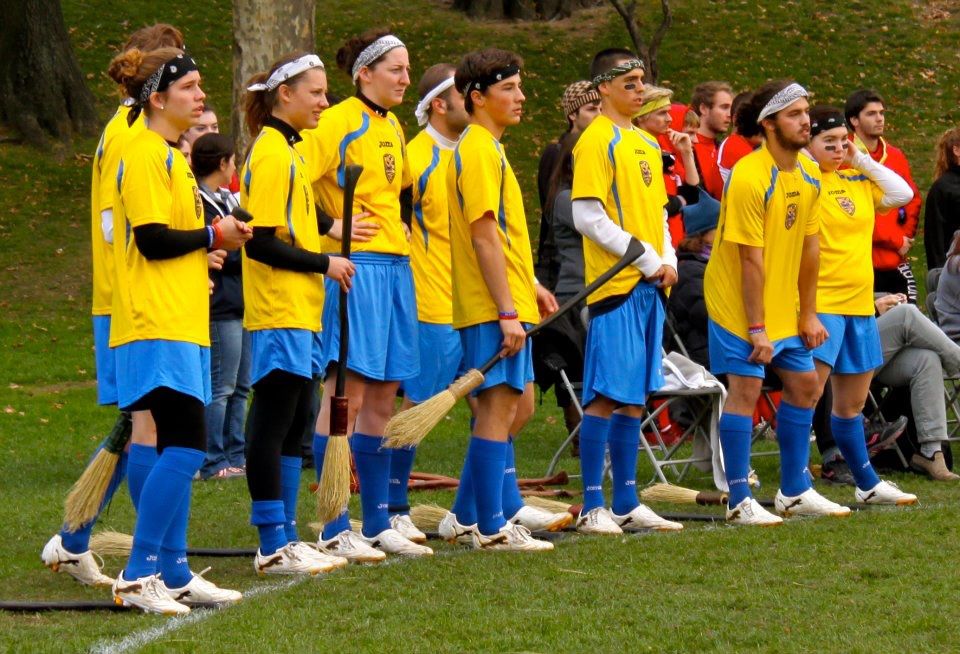- Rule, Britannia, no more?
- Unpopular Opinions: US Quadball Cup 2023
- Proven Contenders: University of Virginia
- Proven Contenders: Rutgers University
- Proven Contenders: University of Michigan
- Proven Contenders: Creighton University
- Different Perspectives: A Look Inside USA Ultimate
- Antwerp QC, Much of Belgian Core, Leaves Competitive Quidditch
Dues: The Key to a Good Team Budget
- Updated: October 25, 2012


Marquette is one of the quidditch world’s sharpest teams thanks to a well-organized dues plan that helps them fund uniform costs. Credit: Nicole Denney
Developing a quidditch team is like managing any other sports team in today’s college scene. There’s paperwork, recruitment, retention of members and matters of money.
When you take a look around the quidditch world, you quickly realize that most teams are charging the bare minimum in dues. They will charge $10 or $20 for a t-shirt and then have players travelling to tournaments pay out of pocket for any costs not covered by fundraising.
This may work on the surface level, but for the overall development of the team – and its bank account – teams need to charge more.
When it comes down to it, $20 covers essentially nothing. Sure, you could get a t-shirt with it, but why do that when there are so many options for full, jersey-material uniforms that will only run you about $15 more? Browse around online a bit and you’ll be sure to find websites with plenty of good deals.
Now, this isn’t to say that t-shirts aren’t an option. If your team has a great graphic design and the ability to produce a quality shirt, save the money and go at it! But, for the most part, you’ll get more bang for your buck by going the jersey route.
So what is a good price for dues? Well, the answer can change depending on team size and how far you are traveling, but a very reasonable goal to start with would be between $50 and $100. This can cover a basic package of a jersey, shorts, socks, headband and travel expenses.
As an example, a Nike jersey, shorts and sock package can be bought for $30. Add in a $1 bandana headband and it brings the total to $31 for a full uniform. That leaves between $19 and $69 for travel. Multiplied by the 21 players allowed on each team’s official roster, the team’s travel budget would begin between $399 and $1,449.
With quidditch moving to a more scheduled, annual season that starts along with the school year, the cost is easier to justify to your team as a sports expense. As the leader of the team, it is your responsibility to show potential new players exactly what they are paying for and where their money is going. Your university and potential new players will appreciate a transparent and easy to follow budget showing how money is used directly to benefit individual players, and how the rest goes towards general team and travel costs.
Marquette University currently charges $200 in dues to returning players and $250 in dues to new players. A few people see this as outrageous and expensive – and some not even connected to the team have expressed their disgust.
But, in reality, the cost really is not that high, and can be justified with a detailed budget breakdown. Those dues cover: two jerseys, shorts and socks for $50 and the team shoe for $25. The remainder of the dues goes toward travel expenses, including food for players at tournaments. This year, dues left the team a $3,675 budget after taking out uniform costs and before fundraising. This general team budget also can be used for costs besides travel, including referee fees, brooms and practice equipment.
Another benefit of higher dues is that they will guarantee a commitment from your players right at the beginning of the season. Some players need the increments and the structure of a dues plan to make payments for team costs. Many will also be comforted by the fact that the team finances are being taken care of, and they will appreciate it when you aren’t scrambling to collect money before every tournament.
The leaders of your team will be thankful as well, while future board members will be able to take advantage of a unified account and paper trail to budget accordingly.
Dues are extremely important. Even if you aren’t looking to set them as high as Marquette, having substantial dues goes a long way in making life easy for your players and providing the means for your team leaders to flexibly use the team’s money as effectively as possible.

5 Comments